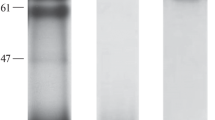Summary
Protoplasts were isolated from oat (Avena sativa L.) leaves by the combination of highly purified preparations of pectin lyase, xylanase, and cellulase C1. During the enzymic isolation, superoxide radical (O 2− ) was generated from the tissues. Both the protoplasts themselves and the cell walls, exposed to enzyme treatment, produced O 2− . Hydrogen peroxide (H2O2) apparently accumulated in the reaction mixture due to the spontaneous dismutation reaction of O 2− , while a part of H2O2 may have been produced directly from cell walls by the action of enzymes. Singlet molecular oxygen (1O2) generated in the reaction mixture was detected by cholesterol oxidation in small unilamellar liposomes. It seems likely that1O2 may be generated by the peroxidase-H2O2-halide system during enzymic treatment of the leaves.
Similar content being viewed by others
References
Badwey, J. A.; Karnovsky, M. L. Active oxygen species and the functions of phagocytic leukocytes. Annu. Rev. Biochem. 49:695–726; 1980.
Cocking, E. C. Plant cell protoplasts. Isolation and development. Annu. Rev. Plant Physiol. 23:29–50; 1972.
Dale, P. J. Protoplast culture and plant regeneration of cereals and other recalcitrant crops. Experientia (Suppl) 46:31–41; 1983.
Doke, N. Involvement of superoxide anion generation in the hypersensitive response of potato tuber tissues to infection with an incompatible race ofPhytophthora infestans and to the hyphal wall components. Physiol. Plant Pathol. 23:345–357; 1983.
Doke, N. Generation of superoxide anion by potato tuber protoplasts during the hypersensitive response to hyphal wall components ofPhytophthora in festans and specific inhibition of the reaction by suppressors of hypersensitivity. Physiol. Plant Pathol. 23:359–367; 1983.
Elstner, E. F. Oxygen activation and oxygen toxicity. Annu. Rev. Plant Physiol. 33:73–96; 1982.
Elstner, E. F.; Heupel, A. Formation of hydrogen peroxide by isolated cell walls from horseradish (Armoracia lapathifolia Gilib.). Planta 130:175–180; 1976.
Evans, D. A.; Bravo, J. E. Protoplast isolation and culture. In: Evans, D. A.; Sharp, W. R.; Ammirato, P. V., et al. eds. Handbook of plant cell culture, vol. 1. New York: Macmillan Publishing Co.; 1983:124–176.
Fridovich, I. Biological effects of the superoxide radical. Arch. Biochem. Biophys. 247:1–11; 1986.
Foote, C. S.; Shook, F. C.; Abakerli, R. B. Characterization of singlet oxygen. Methods Enzymol. 105:36–47; 1984.
Halliwell, B.; Gutteridge, J. M. C. Oxygen toxicity, oxygen radicals, transition metals and disease. Biochem. J. 219:1–14; 1984.
Ishii, S. Cell wall cementing materials of grass leaves. Plant Physiol. 76:959–961; 1984.
Ishii, S.; Mogi, Y. Identification of enzymes that are effective for isolating protoplasts from grass leaves. Plant Physiol. 72:641–644; 1983.
Ishii, S.; Mogi, Y. Isolation and identification of enzymes that are responsible for the isolation of plant protoplasts. In: Potrykus, I.; Harms, C. T.; Hinnen, A., et al., eds. Protoplasts 1983. Basel: Birkhäuser; 1983:6–7.
Ishii, S.; Yokotsuka, T. Purification and properties of pectin lyase fromAspergillus japonicus. Agric. Biol. Chem. 39:313–321; 1975.
Kanofsky, J. R. Singlet oxygen production by lactoperoxidase. Evidence from 1270 nm chemiluminescence. J. Biol. Chem. 258:5991–5993; 1983.
Kanofsky, J. R. Singlet oxygen production by chloroperoxidase-hydrogen peroxide-halide systems. J. Biol. Chem. 259:5596–5600; 1984.
Kulig, M. J.; Smith, L. L. Sterol metabolism. Cholesterol oxidation by singlet molecular oxygen. J. Org. Chem. 38:3639–3642; 1973.
Mäder, M.; Ungemach, J.; Schloss, P. The role of peroxidase isoenzyme groups ofNicotiana tabacum in hydrogen peroxide formation. Planta 147:467–470; 1980.
Misra, H. P.; Fridovich, I. The role of superoxide anion in the autoxidation of epinephrine and a simple assay for superoxide dismutase. J. Biol. Chem. 247:3170–3175; 1972.
Mussell, H.; Strand, L. L. Pectic enzymes. Involvement in pathogenesis and possible relevance to tolerance and specificity. In: Solheim, B.; Raa, J., eds. Cell wall biochemistry. Related to specificity in host-plant pathogen interactions. Tromso: Universitetsforlaget; 1977:31–70.
Ngo, T. T.; Lenhoff, H. M. A sensitive and versatile chromogenic assay for peroxidase and peroxidase-coupled reactions. Anal. Biochem. 105:389–397; 1980.
Noguchi, T.; Takayama, K.; Nakano, M. Conversion of 2,5-dimethylfuran to 2-hydroxy-5-hydroperoxy-2,5-dimethyldihydrofuran, a true1O2-derived reaction in aqueous1O2 generating systems. Biochem. Biophys. Res. Commun. 78:418–423; 1977.
Patnaik, G.; Wilson, D.; Cocking, E. C. Importance of enzyme purification for increased plating efficiency and plant regeneration from single protoplasts ofPetunia parodii. Z. Pflanzenphysiol. 102:199–205; 1981
Pilet, P. E. Introduction. The use of plant protoplasts in physiological research. In: Pilet, P. E., ed. The physiological properties of plant protoplasts. Berlin: Springer-Verlag; 1985:1–5.
Rosen, H.; Klebanoff, S. J. Formation of singlet oxygen by the myeloperoxidase-mediated antimicrobial system. J. Biol. Chem. 252:4803–4810; 1977.
Santos, A. V. P.; Dos; Outka, D. E.; Cocking, E. C., et al. Organogenesis and somatic embryogenesis in tissus derived from leaf protoplasts and leaf explants ofMedicago sativa. Z. Pflanzenphysiol. 99:261–270; 1980.
Stich, K.; Ebermann, R. Investigation of hydrogen peroxide formation in plants. Phytochemistry 23:2719–2722; 1984.
Yamazaki, N.; Fry, S. C.; Darvill, A. G., et al. Host-pathogen interactions. Fragments isolated from suspension-cultured sycamore cell walls inhibit the ability of the cells to incorporate [14C]leucine into proteins. Plant Physiol. 72:864–869; 1983.
Author information
Authors and Affiliations
Additional information
The work was partially supported by the Research Project “Research and development of the improvement of bacterial and plant cells by cell fusion” of the Food and Agriculture Research and Development Association (Japan).
Rights and permissions
About this article
Cite this article
Ishii, S. Generation of active oxygen species during enzymic isolation of protoplasts from oat leaves. In Vitro Cell Dev Biol 23, 653–658 (1987). https://doi.org/10.1007/BF02621075
Received:
Accepted:
Issue Date:
DOI: https://doi.org/10.1007/BF02621075




